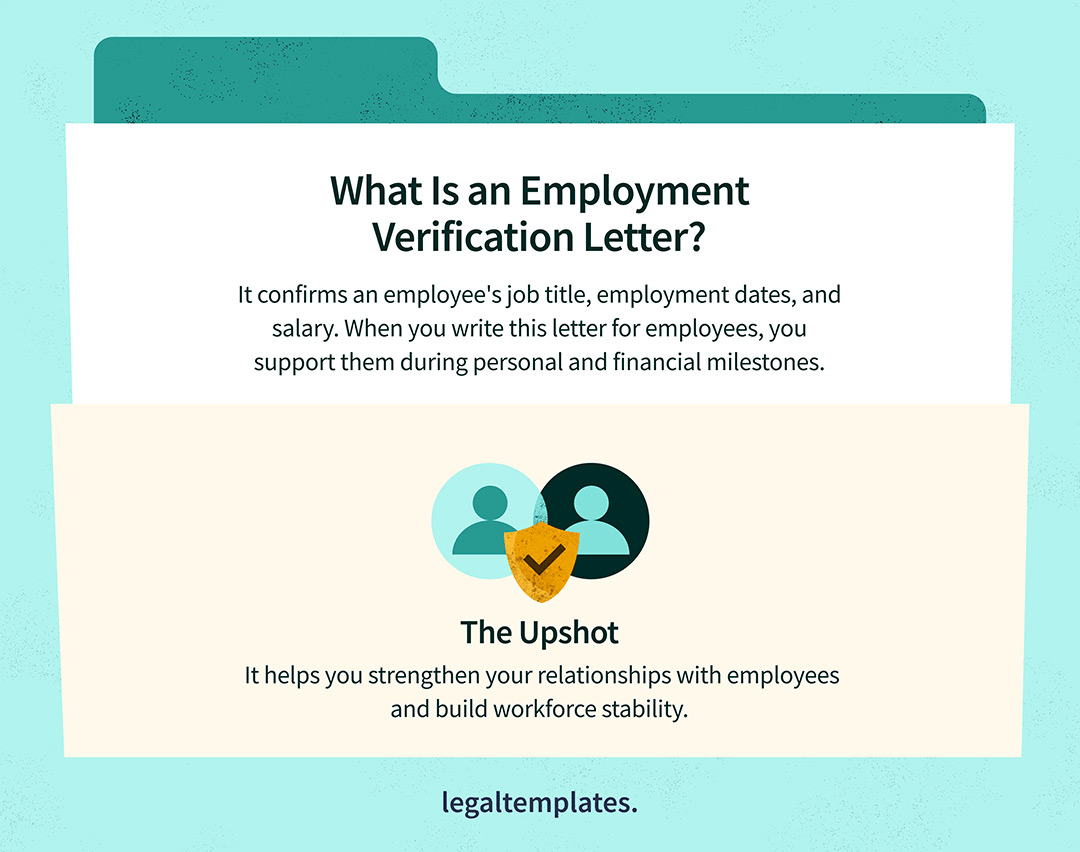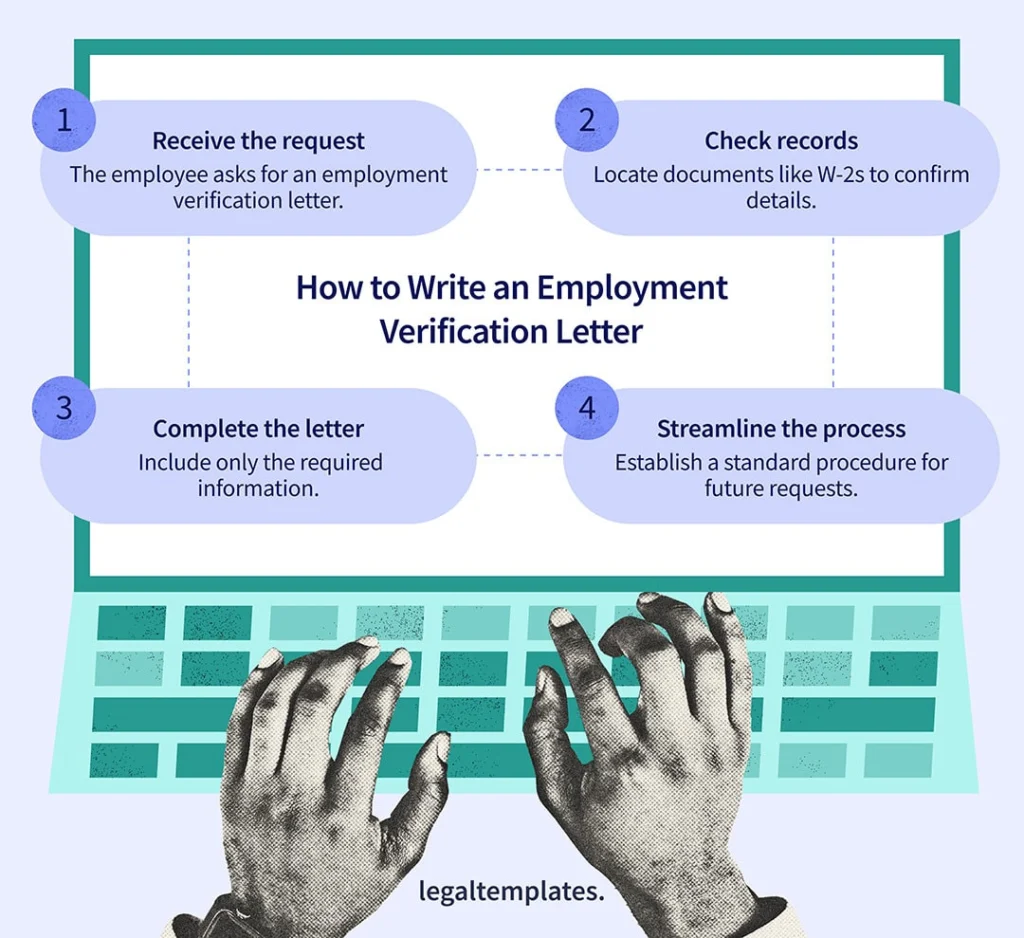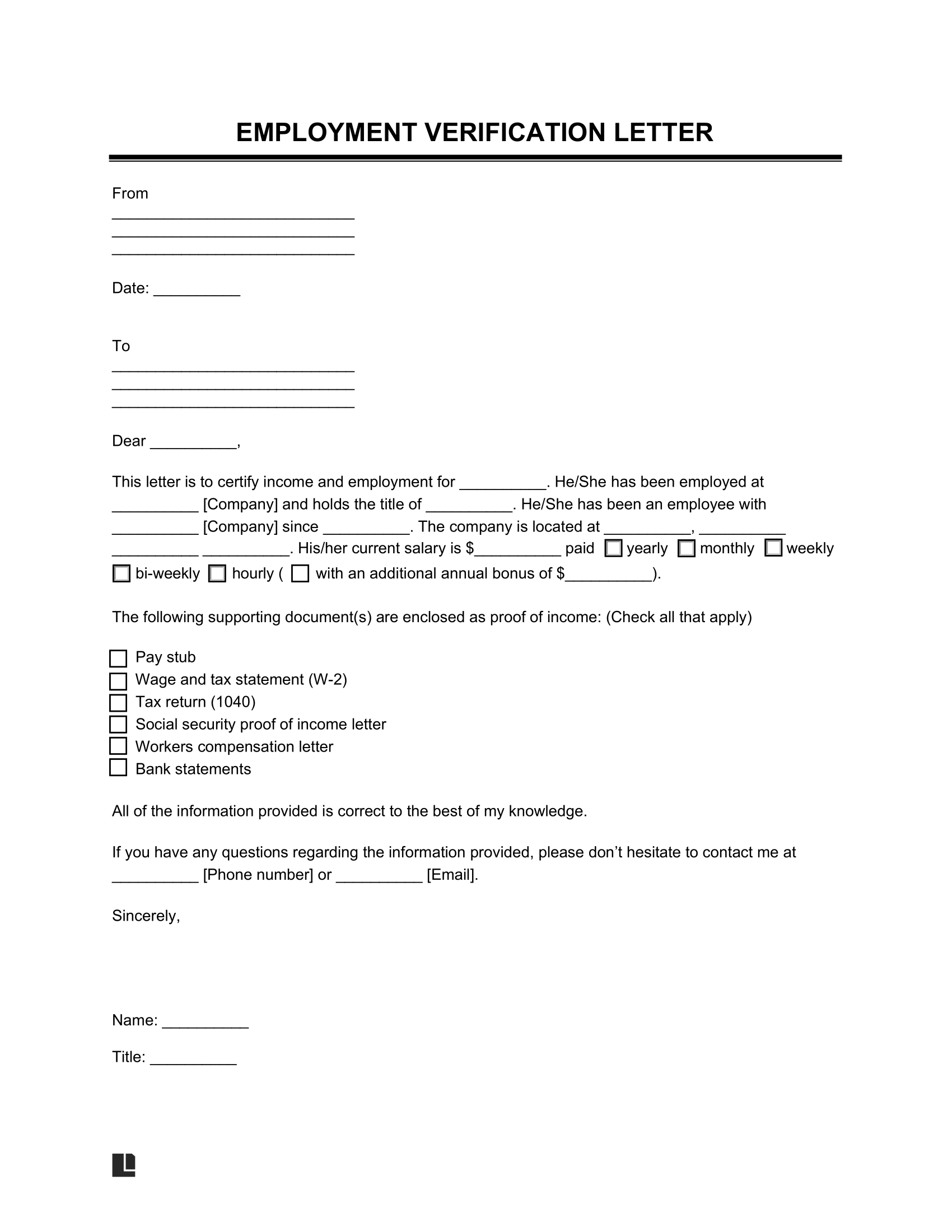What Is an Employment Verification Letter?

An employment verification letter proves a worker’s job status and pay. As an employer, you write and issue this letter after an employee asks for it. It will contain key details, such as the worker’s job title, salary, and start and end dates.
Fill out our employment verification letter template to show your professionalism. Give employees the proof they need to reach their goals, financial or otherwise. Employers who grant employee requests create happier, more stable workforces.
Why Do Employees Need Employment Verification?
Employees request employment verification letters from their employers in the following situations:
- when completing a rental application for a new lease
- when applying for a mortgage or another type of loan
- when attempting to fulfill immigration requirements
- when completing a work permit application
- when going through the visa process
- when filling out a job application for a new job
When employees show they have a stable income, application processors may be more likely to accept them. While an employee can use pay stubs to prove their salary, written work verification provides further evidence.
How to Write an Employment Verification Letter

An employment letter can be short and sweet, sharing only an employee’s work status and salary.
Keep it concise and limit it only to what the employee requests. Follow these steps to create a basic employment verification letter.
1. Receive Request From Employee
An employee usually requests a letter for employment verification. They may email, call, or talk to you in person about their needs.
If desired, consider asking the employee (the requesting party) to fill out a release of liability waiver. This document protects you from liability related to disclosing the requested details.
In some cases, a third party initiates the employment verification request. If this happens, the third party must get the employee’s consent through a wage verification form. Only write the job verification letter if you have the employee’s explicit consent.
2. Refer to Your Employment Records
Search your records for proof of an employee’s employment and salary. Common examples of evidence include bank statements, employment contracts, and W-2 forms.
Refer to these documents as you complete the employee employment verification letter. Don’t provide copies unless the employee requests them. This will protect the employee’s sensitive information.
3. Fill Out the Letter for Employment Verification
Once you have evidence to refer to, start writing the employment confirmation letter. State the letter’s purpose, either to provide salary verification or work verification. Include details such as the employee’s:
- full name
- job title
- job description
- company name
- employment location
- salary
- frequency of payment
- bonuses
Only include the information that the employee requests—omit everything else. Verify that all information is correct to the best of your knowledge. Be sure to keep your statements factual, avoiding judgments about the worker’s conduct. A letter of recommendation is better for giving feedback on an employee’s performance.
Include your contact information so the third party can follow up for clarification.
4. Standardize the Employment Verification Request Process
Employment verifications can be tricky. Third parties have varying needs, and employees often seek detailed letters for future jobs.
Streamline requests by using our employment letter template. Pair it with a standardized process to make these requests easier for everyone.
Prepare instructions to give employees when they request employment or salary verification. Explain what details they need to provide so you can write a thorough letter. Then, set realistic deadlines, including how much notice the employee must give you.
A documented approach benefits employees and employers by ensuring consistency. It can also reduce administrative time and prevent human errors.
Include the documented letter-writing process in an employee handbook. Create one with Legal Templates today.
Employment Verification Letter Sample
View a free employment verification letter template to learn how to confirm an employee’s work history. Once you know all its elements, you can fill out your own and download it as a PDF or Word document.
Examples of Employment Verification Letters
Every employment or salary verification letter will look different depending on who you’re writing it for. Here are three example letters that verify the status of a former employee, independent contractor, and current employee.
1. Employment Verification Letter for a Former Employee
Has a former employee asked for a work verification letter? Refer to this example that highlights a worker’s employment during a specific period.
Greenfield, Inc.
733 Market Street
Los Angeles, CA 90017
February 24, 2025
Summit Property Management
901 Oak Avenue
San Diego, CA 92103
Dear Hiring Manager,
This letter certifies Michael Lawson’s past employment. He worked at Greenfield, Inc., as a Business Analyst from March 2021 to September 2024. The company resides at 733 Market Street, Los Angeles, CA 90017.
When he left, his salary was $85,000 per year with an annual bonus of $5,000.
The information provided is correct to the best of my knowledge.
If you have any questions, please don’t hesitate to contact me at (213) 555-1199 or [email protected].
Sincerely,
Sarah Martinez
HR Manager
2. Employment Verification Letter for an Independent Contractor
Even though independent contractors aren’t traditional employees, you can still verify their work history. Here’s how to structure a proof of income letter if an independent contractor needs you to confirm their pay and work.
Riverstone Construction LLC
825 Oakwood Drive
Cleveland, OH 44125
February 24, 2025
Titan Building Solutions
1150 Lakeside Drive
Cleveland, OH 44125
Dear Hiring Manager,
This letter certifies Ethan Davis’s current independent contractor relationship with Riverstone Construction LLC. Ethan has been working as a Project Manager since January 15, 2024, overseeing various projects.
Ethan gets a monthly retainer of $6,000, with a project-based bonus of 3% for projects that he finishes ahead of schedule.
The information provided is correct to the best of my knowledge.
If you have any questions, please don’t hesitate to contact me at (216) 555-3254 or [email protected].
Sincerely,
Maria Green
Director of Operations
3. Employment Verification Letter for a Current Employee
Consider this example of an income verification letter for an employee who currently works for a company.
Northeast Tech Solutions
93 Innovation Parkway
Portland, ME 04101
February 24, 2025
TechCore Solutions
45 Meridian Avenue
Boston, MA 02118
Dear Hiring Manager,
This letter certifies Samantha Pierce’s current employment at Northeast Tech Solutions. Samantha has worked as a Software Engineer since July 9, 2020. She works at our office at 93 Innovation Parkway, Portland, ME 04101. Samantha’s current salary is $92,000 per year.
The information provided is correct to the best of my knowledge.
If you have any questions, please don’t hesitate to contact me at (207) 555-1347 or [email protected].
Sincerely,
John Marshall
HR Director
What to Know About Employment Verification
Writing an employment verification form comes with responsibilities. Familiarize yourself with information relating to your duties and protections below:
- Consent: Get your employee’s consent before revealing employment status and salary details.
- Response obligations: You should respond to employment verification requests if they come from employees or non-government bodies. You must respond if a government agency makes the request.
- Provision of information: You must only provide truthful, verifiable information in good faith.
Employer Protections for Employment Verification
State laws may protect you when responding to employment verification (VOE) requests. Some offer broad protection, while others only cover certain details, like facts but not opinions. Always check your state’s rules before you respond.
How Legal Templates Helps with Employment Verification
Legal Templates makes employment verification easy. Use our template to enter your employee’s details, and we’ll generate a professional letter for you. Download it as a PDF or Word document, and print when ready—fast, accurate, and hassle-free.
Frequently Asked Questions
Can anyone call HR to verify employment?
Yes, anyone can call HR to verify employment. Companies should only provide employment verification information with the employee’s written consent.
Do I need to notarize an employment verification letter?
In most cases, you don’t need to get an employment verification letter notarized. It may be required or preferred depending on the situation, like if the letter is for visa purposes.
Can an employee write their own employment verification letter?
No. No. Employees should request a signed, company-issued verification letter on official letterhead for credibility.
Employees can provide further proof of income by filling out and submitting Form 4506-T, a request for tax return transcripts, to the IRS.
How to get an employment verification letter?
If you’re an employee seeking an employee verification letter, check your company’s policies. Contact your manager or HR department and give them the details they need to write the letter. Grant explicit permission so they know they can reveal your employment details.
How to request an employment verification letter from HR by email?
Write a clear and concise email. Include your name, employee ID number, and reason for writing. Specify the information you want HR to highlight, like employment dates. Include a polite request and details on how HR can contact you.


